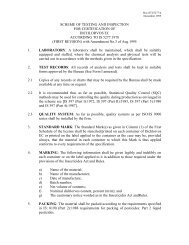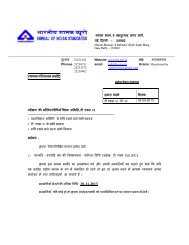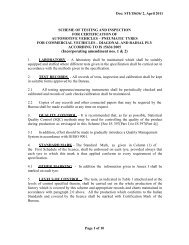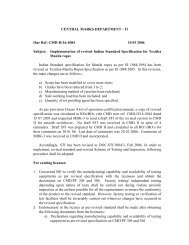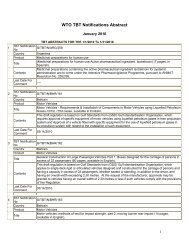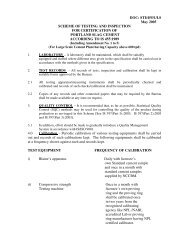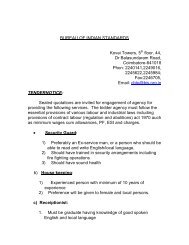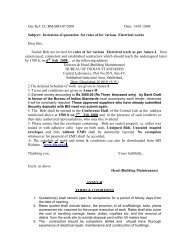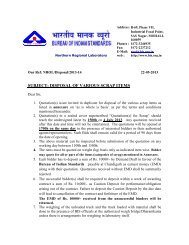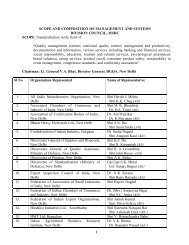Doc ET 11 (6497) SECONDARY CELLS AND BATTERIES FOR ... - Bis
Doc ET 11 (6497) SECONDARY CELLS AND BATTERIES FOR ... - Bis
Doc ET 11 (6497) SECONDARY CELLS AND BATTERIES FOR ... - Bis
You also want an ePaper? Increase the reach of your titles
YUMPU automatically turns print PDFs into web optimized ePapers that Google loves.
Draft Indian Standard<strong>Doc</strong> <strong>ET</strong> <strong>11</strong> (<strong>6497</strong>)<strong>SECONDARY</strong> <strong>CELLS</strong> <strong>AND</strong> <strong>BATTERIES</strong><strong>FOR</strong> SOLAR PHOTOVOLTAIC APPLICATIONGENERAL REQUIREMENTS <strong>AND</strong> M<strong>ET</strong>HODS OF TEST1 SCOP<strong>ET</strong>his Indian Standard gives general information relating to the requirements of the secondary batteriesused in photovoltaic energy systems (PVES) and to the typical methods of test used for theverification of the battery performances. This specification deals with cells and batteries used in solarphotovoltaic application.This Indian Standard does not include specific information relating to battery sizing, method of chargeor PVES design.This standard is applicable to secondary cells and batteries of Lead-acid and Nickel based chemistry.2 NORMATIVE REFERENCESThe following referenced documents are indispensable for the application of this document. For all thereferences, the latest edition of the referenced document (including any amendments) applies.IS 1651 : Stationary Cells and Batteries, Lead-acid type [with Tubular positive plates]IS 13369 : Stationary lead-acid batteries [with tubular positive plates] inmonobloc containersIS 15549 : Stationary Valve regulated lead-acid batteries- specification,IS 15767 : Secondary Cells and Batteries containing Alkaline or other Non-acid electrolytes –Nickel-Cadmium Prismatic Secondary Single Cells with Partial Gas RecombinationIEC 62259 ed.1.0: – Secondary Cells and batteries containing alkaline or other non acid electrolytes–Nickel-Cadmium prismatic secondary single cells with partial gas recombinationIS: 10893 : Specification for sealed Nickel-Cadmium Button type rechargeable single cellsIS: 10918 : Vented types Nickel - Cadmium Batteries Ammendments1-2007. Equivalent to IEC623[1978]IEC 61951 -1: Secondary cells and batteries containing alkaline or other non-acid electrolytes –Portable sealed rechargeable single cells-Part 1; Nickel-CadmiumIEC 61951 : Secondary Cells and Batteries containing alkaline or other non-acid electrolytes-Portable sealed rechargeable single cells-Part2: Nickel metal hydride, second edition 2003-04
IRS: S 88/2004 Low Maintenance Lead-acid stationary cells for S&T installations3 TERMS <strong>AND</strong> DEFINITIONSFor the purpose of this document, the definitions and terms for secondary cells and batteries given inIS 1885 : part 15 and IEC 61427-1 shall apply.4 CONDITIONS OF US<strong>ET</strong>his clause specifies the particular operating conditions experienced by secondary batteries inphotovoltaic applications during their use.4.1 Photovoltaic energy systemThe photovoltaic energy system with secondary batteries referred to in this standard can supply aconstant, variable or intermittent energy to the connected equipment (lighting systems,communication systems etc.).4.2 Secondary cells and batteriesSecondary cells and batteries mainly used in photovoltaic energy systems are of the following types:Vented (flooded);Valve-regulatedThe cells and batteries are normally delivered in filled & charged or unfilled & uncharged.In case of partial gas recombination, Ni-Cd cells & batteries shall be delivered in filled and charged orfilled & discharged.For optimum service life, the battery manufacturer’s instructions for initial charge of the battery shallbe followed.4.2.1 Material and Constructiona. GeneralAll the materials used in the manufacture of stationary batteries for photovoltaic system shall be thebest of their respective kind, free from flaws and defects and shall conform to the relevant Indianstandard, if any. The quality of raw material used and the manufacturing method employed forconstructing the cell / battery must ensure that parameters important for the SPV application such aswater loss (related to service interval), charge acceptance and self discharge loss are kept at theoptimal level for the application.4.3 General operating conditions
Batteries in a typical PV system operating under average site weather conditions may be subjected tothe following conditions:4.3.1 Autonomy timeThe battery is designed to supply energy under specified conditions for a period of time, typicallyfrom 3 days to 15 days, with or without solar radiation.NOTE – When calculating the required battery capacity, the following items should be considered, e.g.:• Required daily/seasonal cycle (there may be restrictions on the maximum depth of discharge,DOD shall be limited to 80% at the end of autonomy)• Time required to access the site• Aging• Operating temperature• Future expansion of the load4.3.2 Typical charge and discharge currentsThe typical charge and discharge currents are the following:(a) Maximum boost charge current: C/10 A(b) Average float / trickle charge current: C/50A(c) Average discharge current determined by the load: C/120 A.Where C refers to the 120 hour rated capacity of the cell/battery.NOTES1 Depending on the system design, the charge and the discharge current may vary in a wider range.2 In some systems the load current must be supplied at the same time as the battery charging current4.3.3 Daily cycleThe battery is normally exposed to a daily cycle as follows:a. Charging during daylight hours.b. Discharging during night-time hours.A typical daily usage results in a discharge between 2% - 20% of the battery capacity.
4.3.4 Seasonal cycleThe battery may be exposed to a seasonal cycle of state of charge. This arises from varying averagechargingconditions as follows:Periods with low solar irradiation, for instance during rainy season / monsoon season causinglow energy production. The state of charge of the battery can go down to 20% of the ratedcapacity.Periods with high solar irradiation, e.g. in during other seasons, this will bring the battery up tothe fully charged condition, with the possibility that the battery could be overcharged.4.3.5 Period of high state of chargeTypically, In Indian operating conditions, batteries will be operated at high state of charge between 80to 100% of rated capacity during seasons other than the monsoons, unless batteries & systems are notproperly sized.A voltage regulator system normally limits the maximum battery voltage during the recharge period.When generation voltage exceeds beyond the limits, the controller should trip-off and reconnect backas soon as the generation voltage comes to normal range to avoid any delay in charge cycle. Chargecontroller should be sized accordingly to keep the battery & load always safe & getting charged.The system designer normally chooses the maximum charge voltage of the battery (as applicable toeach battery technology) as a compromise allowing to recover to a maximum state of charge (SOC) asearly as possible in the seasons other than the monsoon but without substantially overcharging thebattery.The overcharge increases the gas production resulting in water consumption in vented cells. In valveregulated lead acid cells, the overcharge will cause a lesser increase of water consumption and batteryinternal temperature there by reduction in battery life.Typically the maximum charge voltage is 2.4 V per cell for lead-acid batteries and 1.55V per cell forvented nickel-cadmium batteries (refer manufacturers recommendations). These values are applicablefor the reference temperature specified by the manufacturer.The expected life-time of a battery in a PV system even kept regularly at a high state of charge may beconsidered less than the published life of the battery used under continuous float charge.4.3.6 Period of sustained low state of chargeDuring periods of low solar radiation, the energy produced by the photovoltaic array may not besufficient to fully recharge the battery. The state of charge will then decrease and cycling will takeplace at a low state of charge. The low solar irradiation on the PV array may be a result of thegeographical location combined with the monsoon, snow periods, heavy clouds, rains or accumulationof dust on photovoltaic array.
4.3.7 Electrolyte stratificationElectrolyte stratification may occur in lead-acid batteries. In vented lead acid batteries, electrolytestratification can be avoided by electrolyte agitation/recirculation or periodic overcharge whilst inservice. In valve regulated lead-acid (VRLA) batteries, electrolyte stratification can be avoided bydesign or by operating them according to the manufacturer instructions.”4.3.7.1 Specific GravityThe specific gravity of electrolyte for flooded lead acid battery shall be 1.240±0.005. This is specificrequirement for cells / batteries for SPV application and shall override all other requirementsspecified in any other standard.4.3.8 StorageManufacturer’s recommendations for storage shall be observed. In the absence of such information,the storage period may be estimated according to the climatic conditions as shown in the Table 1 asbelow.Table 1 – Limit values for storage conditions of batteries for photovoltaic applicationsStorage period for Storage periodbatteries for batteriesBattery type Temperature range HumidityWithoutWith electrolyteelectrolyteLead-Acid -20 to +50 0 C
4.3.9 Operating temperatureThe temperature range during operation experienced by the battery at the site is an important factor forthe battery selection and the expected lifetime.Manufacturer’s recommendations for operating temperatures and humidity shall be observed. In theabsence of such information, operating temperatures and humidity may be those shown in the Table 2as below.Table 2 – Limit values for operating conditions of batteries for photovoltaic applicationsBattery type Temperature range HumidityLead-Acid -20 to +50 0 C
• Explosive atmospheres• Flooding, water vapour condensation and water spray.• Earthquakes• Shock and vibration (Particularly during transportation)5 GENERAL REQUIREMENTS5.1 Mechanical enduranceBatteries for photovoltaic application shall be designed to withstand mechanical stresses duringnormal transportation and handling. Additional packing or protection shall be used for off-roadconditions.Particular care shall be taken while handling unpacked batteries & Manufacturer’s instructions shallbe followed. In case of specific requirements regarding mechanical stresses, such as earthquakes,shock and vibration, these shall be individually specified or referred to the relevant standard.5.2 Charge efficiencyThe charge efficiency is the ratio between the quantity of electricity delivered during the discharge ofa cell or battery and the quantity of electricity necessary to restore the initial state of charge underspecified conditions.NOTE – The quantity of electricity is expressed in Ampere-hours(Ah).Where no data is available from the battery manufacturer, the following efficiencies as given in Table3 may be assumed.Table 3 – Battery Ah-efficiency at different state of charge at the reference temperature and adaily depth of discharge of less than 20% of the rated capacityState of charge(SOC)PercentEfficiencylead-acid cellsPercentEfficiencyNi-Cd and Ni-MH cellsPercent90 >85 >8075 >90 >9095 >95Note: Charge efficiency reduces at high SOC as compared to lower SOC.5.3 Deep discharge protectionLead-Acid batteries shall be protected against deep discharge to avoid loss of capacity due toirreversible sulphation. This could be achieved by using a system, which monitors the battery voltageand automatically disconnects the battery before it reaches its maximum depth of discharge (seemanufacturers recommendations).
Vented and partial gas recombination Nickel-cadmium batteries do not normally require this type ofprotection.5.4 MarkingCells or monobloc batteries shall follow the instructions of the applicable standards defined in 7.2.5.4.1 BIS Certification MarkingThe cells may also be marked with Standard Mark.5.4.2 The use of the Standard Mark is governed by the provisions of the Bureau of Indian StandardsAct, 1986 and the rules and regulations made thereunder. The details of condition under which a licencefor the use of the Standard Mark may be granted to manufacturers or producers may be obtained from theBureau of Indian Standards.5.5 SafetyApplicable local regulations and the manufacturer’s instructions for procedure to be observed duringinstallation, commissioning, operation, taking out of service, and disposal shall be followed.5.6 <strong>Doc</strong>umentationManufacturer’s documentation for the transport and storage, commissioning, putting into service,operation and maintenance shall be followed.Generally, the initial charging of the battery at site shall be done as per manufacturer’s general guidelinewith proper chargers provided. However, for initial charging at site where only SPV arrays are availableas power source, specific instruction to be obtained from the manufacturer for initial charging on a case tocase basis.6 FUNCTIONAL CHARACTERISTICSThe following parameters need to be tested for qualification of a cell/battery according to thisspecification :• Rated capacity (see 8.1)• Endurance (see 8.2)• Charge retention (see 8.3)• Cycling endurance in photovoltaic application (extreme conditions) (see 8.4)• Recovery from Sulphation test (see 8.5)• Water loss on float charge (see 8.6)
7 GENERAL TEST CONDITIONS7.1 Accuracy of measuring instrumentsWhen testing batteries, the parameters and accuracy values shall be in accordance with relevantclauses of the IS standards listed in 7.2The accuracy of the measuring instruments shall be in compliance with the relevant Indian Standardlisted in 7.27.2 Standards to be referred for testingTests for which detailed procedures are not given in this standard, established procedure given in thefollowing standards are to be adopted:• IS 1651& IS 13369 for stationary lead-acid batteries (vented types);• IS 15549 for stationary lead-acid batteries (valve-regulated types);• IS 10893 & IS 10918 for vented nickel-cadmium battereies;• IS 15767 / IEC 62259 for nickel cadmium prismatic rechargeable single cells with partial gasrecombination;• IEC 61951-1 for portable nickel-cadmium batteries;• IEC 61951 – 2 for portable nickel metal hydride batteries;• IRS: S 88/2004 Low Maintenance Lead-acid stationary cells for S&TInstallations• TEC/GR/TX/BAT- 003/02 MAR20<strong>11</strong> <strong>FOR</strong> Tubular VRLA batteries based on Gel technology• TEC/GR/TX/BAT – 001/04 JUNE 20<strong>11</strong> For VRLA batteries8 TEST M<strong>ET</strong>HOD8.1 Capacity testTest samples shall be set up in accordance with the applicable standards in 7.2. Tests to verify therated capacity shall be performed using a current of I 10 (A) for lead-acid batteries and I t /5 (A) fornickel-cadmium and Ni-MH batteries, according to the relevant clauses in the IS standards listed in7.2.Requirement: As per the standards mentioned in 7.2.8.2 Endurance testTest samples shall be tested according to the applicable standards described in 7.2.8.3 Charge retention testTest samples shall follow the procedures of the applicable standards described in 7.2.
8.4 Cycle endurance in photovoltaic application (extreme conditions)In photovoltaic application the battery will be exposed to large number of shallow cycles but atdifferent states of charge. The cells or batteries shall therefore comply with the requirements as testedbelow, which is a simulation of the photovoltaic energy system operation.The cycle endurance test is an accelerated simulation in extreme conditions of the battery operation ina photovoltaic energy system and shall be conducted by submitting the cells or monobloc batteries toa period of 150 cycles (50 cycles with the phase A and 100 cycles with the phase B).Samples shall be selected for conducting this test as per Clause no. 9.1Start the test with fully charged battery. Bring the battery to a temperature of 40ºC±3ºC and stabilizefor 16h. Maintain the battery at 40ºC±3ºC throughout the test.Total cycles per unit = 150 (Phase A 50cycles + Phase B 100 cycles).8.4.1 Phase A: Shallow cycling at low state of chargeLead –acid batteriesa) Discharge the batteries with a current I 10 (A) during 9 hrs or until 1.75 v /cell is reached which everis earlier.b) Recharge 3hrs with a current 1.03 x I 10 (A)c) Discharge 3hrs with a current I 10 (A)Nickel – Cadmium and Ni-MH batteriesa) Discharge the batteries with a current I t /10(A) during 9 hrs or until 1.0 v /cell is reached.b) Recharge 3hrs with a current 1.03 x I t /10(A)c) Discharge 3hrs with a current I t /10(A)Table 4 – Phase A shallow cycling at low state of chargeDischarge timehCharging timehLead-acid currentANi-Cd and Ni-MH currentAI 10 (A)I t /10(A)a) 9(or stopping at 1.75V/cell)(or stopping at 1.00V/cell)b) 3 1.03x I 10 (A) 1.03x I t /10(A)c) 3 I 10 (A) I t /10 (A)Repeat b) to c) 49 times and continue to phase B
8.4.2 Phase B: Shallow cycling at high state of chargeLead –acid batteriesa) Discharge the battery for 2hrs with a current 1.25x I t /10 (A).b) Recharge 6hrs with a current I 10 (A). The charge voltage shall be limited to 2.4 V/cell unlessotherwise specified by the manufacturer.Nickel- cadmium and Ni-MH batteriesa) Discharge the battery for 2hrs with a current 1.25x I t /10(A).b) Recharge 6hrs with a current I t /10(A). The charge voltage shall be limited to1.55 V/cell unless otherwise specified by the manufacturer.For both battery types, repeat b) and c) 99 times and then perform a capacity determination accordingto 8.4.3. Phase B is summed up in Table 6.Table 5 – Phase B Shallow cycling at high state of chargeNi-Cd and Ni-MHDischarge time Charging time Lead-acid currentcurrenthhAAa) 2 1.25 I 10 (A) 1.25 I t /10(A)b) 68.4.3 Capacity checkI 10 (A)(charge voltage limited to2.4V/cell unlessotherwise specified bythe manufacturer)Repeat a) to b) 99 timesI t /10(A)(charge voltage limitedto 1.55V/cell unlessotherwise specified bythe manufacturer)After the phase B, the battery is cooled down to the temperature defined in the relevant standard asdescribed in 7.2 and stabilized at this value for 16hrs. The capacity test C 10 for Lead acid and C 5 forNickel-cadmium & Ni-MH batteries is carried out according to the relevant standard as described in7.2.8.4.4 End of test condition(d) Capacity is checked after each period of 150 cycles (phases A+B).(e) The value of actual capacity determined in 8.4.3 shall be recorded.(f) The cycle life shall be expressed in number of 150 cycle (A+B) sequences completed.(g) The test is finished.During the phase A: when the cell voltage measured in discharge is lower than 1.5V/cellfor lead acid batteries and 0.8V/cell for Ni-Cd and Ni-MH batteries.After the phase B: when the checked capacity measured in 8.4.3 is lower than 80% of therated capacity.
8.4.5 Water consumption of flooded battery types and cells with partial gas recombinationDuring the endurance test, vented type batteries may be topped up with water. The amount of wateradded shall be measured and reported.8.4.6 RequirementThe minimum number of complete (A+B) sequences (150 cycles) achieved shall be 3 [three]. At theend of the test the C 120 capacity shall not be less than 80% of the rated.8.5 Sulphation Test (Applicable for Lead acid batteries only)The test is to be carried out on a fully charged cell / battery. The test shall be carried out as describedin 8.5.1 & 8.5.2.8.5.1 Flooded Type Batteriesa)Discharge at a rate of 0.0135 x C10 for a period of 24 hours.b)Leave the battery for 120 hoursc)Recharge at 0.056 x C10 for 4 hours followed by 0.0135 x C10 for 12 hours.d)Discharged at 120 hour rate (i.e. 0.0125 x C10 to an end voltage of 1.9V / cell).Requirement :The battery shall give at least 108 hours.8.5.2 VRLA Batteriesa) Discharge at a rate of C/80 for a period of 24 Hrs.b) Leave the battery on open circuit for 120 Hrs (5 days)c) Recharge in constant current mode at C/20 for 4 Hours followd by C/80 for 12 Hrs.d) Discharge at C/10 rate to an end voltage of 1.900 V/cell or <strong>11</strong>.40 V/mono-blockRequirement : The cell/mono-block/battery should give at least 108 hours.8.6 Water loss test (valid for flooded lead acid batteries only)The water loss test shall be done as per the latest version of the relevant specification with all itsamendments mentioned in clause 7.2 of this specification.8.7 Non spillability/semi Non spillability/splash proof test8.7.1 Applicability : Lead Acid Batteries (BSLA)8.7.2 Requirements : The vent plug shall be of the anti splash/nonspillable/semi non-spillable type withmore than one exist hole and shall allow the gases to escape freely.
8.7.3 Method : Immediately after capacity discharge at one hour rate adjust the electrolyte level to theheight stated by the manufacture on the instruction label. The battery shall then be put on chargeat normal rate with the vent plug, screwed tightly. When the battery is fully charged as obtainedfrom voltage readings, allow the battery to stand on open circuit for half an hour after whichbattery shall be subjected to the following test as applicable for two hours.(a) Kept upside down for non-spillability(b) Laid on any one of its for semi-non-spillability(c) Tilted at an angle of 45° from the plane for splash test8.7.4 Observations: No leakage from vent plug and battery.9 RECOMMENDED USE OF TESTS9.1 Type testType tests are:– the rated capacity test and the charge retention test– the endurance test– the cycling endurance test in photovoltaic application (extreme condition)– Sulphation Test (applicable for Lead Acid batteries only).– Water loss test (valid for flooded lead acid cells/batteries only)The minimum number of samples shall be as specified in the relevant standards listed in 7.2The endurance test in photovoltaic application shall be performed on two cells (or two battery packs,or two 6-cells blocks for lead-acid batteries).9.2 Acceptance test9.2.1 Factory testThe acceptance test shall be agreed between the customer and the supplier. Compliance to marking,labeling rated capacity may be verified.9.2.2 Commissioning testA commissioning test is recommended to prove the integrity of the installed battery system by means of acapacity test @ 10 hr rate.------------------



